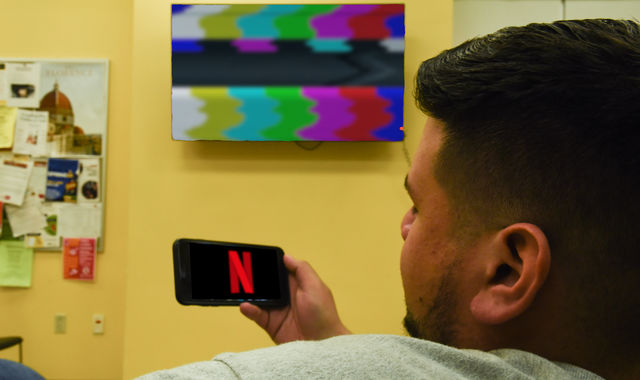Live TV is Dead
Illustration by Mark David Magat
In this photo illustration a Netflix logo seen displayed on a smartphone
That which is on television is no longer considered must-see with social media. Viewers could see everything on their timelines. With streaming services adding episodes all at once, the-week by-week viewing no longer exists. The Grammys, the Oscars, and the NBA all-star games are all live television events that happened recently, the main talking points of which one can gain an understanding of by simply scrolling through Twitter.
Television shows have lost their reasons for viewers to tune in every week. Before the age of streaming, you’d have to wait months after a season’s finale aired to be able to purchase a DVD of the season in order to watch it all at once. Nowadays, streaming services like Hulu and Netflix release seasons all at once. As for the shows that actually air on cable television, it feels like it has been forever since the last episode aired when you have to actually wait until a particular time to see the most recent one. Over the past three decades, television has really been flipped upside down.
Network television began to be at its peak in the 90s, when sitcoms like “Friends”, “Seinfeld”, and “Frasier” were what people enjoyed watching. And on the unscripted side, people were glued to their chairs watching the O.J. Simpson trial play out. By the time the 2000s rolled around, viewers wanted something more real. Reality television came onto the scene, and shows like “American Idol” and “The Real World” were things viewers were excited about.
Scripted television was not left out when cable television began to create their own television programs. Networks like FX and HBO began to take over what network television used to be. By the 2010s, we seemed to arrive at a new golden age of television. It was nothing like it once was, having so many different options viewers can have difficulty deciding what to watch.
Then came Netflix, first considered the brand new Blockbuster, only used for renting movies without ever having to leave the home. Once the demand for DVDs fell, they created a new option for viewers. The era of streaming began. Now viewers can watch whatever they want, whenever they want, without having to record anything or run home to catch the new episode of show at a particular time.
Take the example of “Friends”, which aired primetime on NBC for ten years. After a season would air, fans would either have to wait for reruns or for the home video edition to be released in order to re-watch or catch up on a season. When streaming came around, new seasons were added immediately after the season just aired. Today, networks like The CW will add titles less than a month after airing. Next month, FX will begin to add all their new programs, as well as past seasons of old programs. Putting all their programs into one streaming app takes away the reason for paying for cable. If a viewer is watching something knowing that in a few days —maybe even hours — it will be added to Hulu or on-demand, then live television is coming to an end.
Social media is also killing live television — Currently, the Democratic Presidential Debates have been taking place, and instead of sitting through and watching everything they talk about, one can simply go on Twitter and watch videos of the highlights and the main talking points of the debate. This can apply to sports as well — People are paying top money to watch the latest UFC fight, but if a person just waits for the biggest knockout that everyone is talking about, updates concerning the event are everywhere.
Some would argue that watching live is far better than binging everything at once or watching the highlights on social media. The suspense of watching a program week-by-week can enhance one’s viewing experience. Avoiding spoilers can be a big challenge for viewers today. Those who can successfully avoid them can have an experience that many don’t have enough patience to preserve.
If a viewer goes channel-surfing and sees every commercial for a new show, the airdate or the option to watch on demand will be shown at the end of the ad. It has become very clear that we are approaching a new era of television in which we stream everything at our own pace, and ask our friends, “Have you checked out this new show?” rather than “Did you catch the new episode of that show?”







